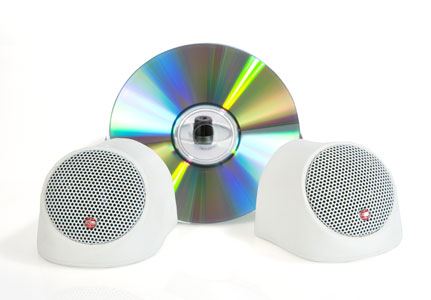Review: So-Na-Wall SonaPod Speakers Page 2

SETUP
To mount each SonaPod in the corners of my home theater, I attached a small plastic plate to the wall using a drywall screw. I then placed a piece of special ultra-strong double-stick tape provided with the speakers. (The plastic plate lets you remove the speaker without scratching up your wall paint.) Each speaker is hard-wired with a piece of slim cable. I connected these cables to the output of the crossover module, then connected two more cables from the crossover module to the Sunfire CRM-2 left and right speakers in my system.
The crossover module has one knob and two switches. The knob controls volume. A three-position switch selects the high-pass filter frequency, and a two-position switch sets the level. The switches interact, so the filter frequencies change when the level changes. At the -7 dB level setting, filter frequencies are 800, 400, and 150 Hz. At the -11 dB level setting, filter frequencies are 500, 250, and 100 Hz. It's all rather confusing and a bit scary when you realize that the SonaPods' little drivers can easily be damaged by low-frequency sounds.
At the suggestion of So-Na-Wall's Kenneth Persson, I set both switches to Hi, thus setting the level at -7 dB and filtering out sounds below 800 Hz. I tweaked the volume knob until the mix sounded right to me: loud enough that I noticed the SonaPods' contribution, but not so loud that it dramatically changed the system's sound.
One caution about installing the sPodak system: It can drop the impedance of your left and right speakers enough to cause concern. Measurements made with my LinearX LMS showed that the combined impedance of the SonaPods and the crossover module drops to about 10 ohms above the high-pass filter frequency setting. When I did impedance measurements of a Boston Acoustics RS 344 tower speaker with and without the sPodak system connected, adding the sPodak dropped the impedance by about -0.5 ohms below the filter frequency and about -3 ohms above the filter frequency. If you're running a speaker with a 7- or 8-ohm nominal impedance, this drop probably won't overstress your receiver. But if you're running a speaker with 4 ohms nominal impedance, adding the sPodak will push the total impedance above the filter frequency down to 2.9 ohms, demanding more current than some bargain-basement receivers can supply and possibly causing them to shut down.
I later tried the SonaPods as stereo speakers on their own, connected to So-Na-Wall's ST-100 subwoofer. The 100-watt subwoofer incorporates a speaker-level crossover to filter the lows out of the SonaPods. I connected wires directly from my AudioControl Savoy amplifier to the ST-100's speaker-level inputs, then more wires from the ST-100 to the SonaPods. The sub offers knobs for level and the frequency cut-off of its internal low-pass filter (which filters the mids and highs away from the 6.8-inch woofer). After some experimentation, I settled on a frequency of 120 Hz. Lower than that and there was too much of a "hole" between the sub and the SonaPods; higher than that and too much voice came out of the sub, making singers sound bloated.
The SonaPods cost $299 per pair on their own and the ST-100 costs $599, making the total system price $898. That's not cheap, but it's priced competitively with a lot of ceiling speakers - and in many cases, it'll be easier and more practical to install because it doesn't require cutting holes in the ceiling.
- Log in or register to post comments




















































